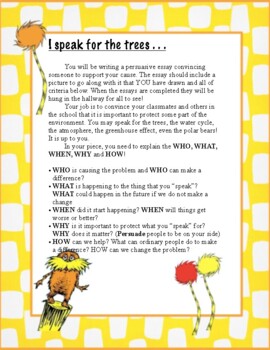The Lorax and the Environment
Julie Browne
1 Follower
Grade Levels
3rd - 7th
Subjects
Resource Type
Standards
NGSS5-ESS3-1
NGSSMS-ESS3-4
NGSSMS-ESS3-3
NGSS4-ESS3-2
NGSS4-ESS3-1
Formats Included
- Zip
Julie Browne
1 Follower
Description
Read the Dr. Seuss story The Lorax as part of a unit on how humans affect the environment and the atmosphere. This packet includes a multi-page worksheet to be used with the book to get students thinking about relating the book to the unit. Also including are product descriptor and rubric for a project of writing their own children's book like The Lorax that conveys a message about protecting natural resources and the environment.
Total Pages
Answer Key
N/A
Teaching Duration
N/A
Report this resource to TPT
Reported resources will be reviewed by our team. Report this resource to let us know if this resource violates TPT’s content guidelines.
Standards
to see state-specific standards (only available in the US).
NGSS5-ESS3-1
Obtain and combine information about ways individual communities use science ideas to protect the Earth’s resources and environment.
NGSSMS-ESS3-4
Construct an argument supported by evidence for how increases in human population and per-capita consumption of natural resources impact Earth’s systems. Examples of evidence include grade-appropriate databases on human populations and the rates of consumption of food and natural resources (such as freshwater, mineral, and energy). Examples of impacts can include changes to the appearance, composition, and structure of Earth’s systems as well as the rates at which they change. The consequences of increases in human populations and consumption of natural resources are described by science, but science does not make the decisions for the actions society takes.
NGSSMS-ESS3-3
Apply scientific principles to design a method for monitoring and minimizing a human impact on the environment. Examples of the design process include examining human environmental impacts, assessing the kinds of solutions that are feasible, and designing and evaluating solutions that could reduce that impact. Examples of human impacts can include water usage (such as the withdrawal of water from streams and aquifers or the construction of dams and levees), land usage (such as urban development, agriculture, or the removal of wetlands), and pollution (such as of the air, water, or land).
NGSS4-ESS3-2
Generate and compare multiple solutions to reduce the impacts of natural Earth processes on humans. Examples of solutions could include designing an earthquake resistant building and improving monitoring of volcanic activity. Assessment is limited to earthquakes, floods, tsunamis, and volcanic eruptions.
NGSS4-ESS3-1
Obtain and combine information to describe that energy and fuels are derived from natural resources and that their uses affect the environment. Examples of renewable energy resources could include wind energy, water behind dams, and sunlight; non-renewable energy resources are fossil fuels and fissile materials. Examples of environmental effects could include loss of habitat due to dams, loss of habitat due to surface mining, and air pollution from burning of fossil fuels.



